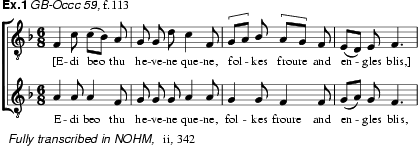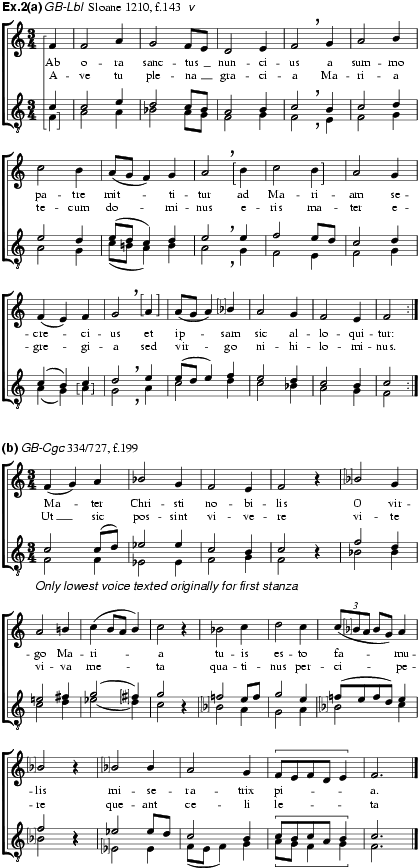
A Latin term meaning ‘song’, ‘melody’ and, secondarily, the blending of two or more simultaneous melodic entities (i.e. synonymous with concentus). The term designated a variety of musical phenomena in the Middle Ages. It crops up as a term for plainchant, especially for chants other than psalmody, primarily those which render not biblical prose but poetic texts or texts tending towards poetry (e.g. prosae). From the 9th century onwards cantilena was often associated with non-ecclesiastical monophony. Hence, the term was applied to jongleurs’ songs, as well as to the secular refrain forms that Johannes de Grocheo (c1300) identified with music of the people of northern France: rondeau, and (without text) stantipes and ductia. The subsidiary meaning of the word may account for its use – in contrast to cantio – in connection with certain types of polyphony. In the 9th and 10th centuries it could designate the new (parallel) organum (GerbertS, i, 165b; CoussemakerS ii, 74b). From about 1270 on it was applied to polyphonic song not based on a cantus firmus (other than the declining conductus): polyphonic rondeaux, such as those by Adam de la Halle (Franco – CSM, xviii, 69, similarly by other authors – Jacques de Liège, CSM, iii, 24; CoussemakerS, i, 302a; iii, 361a; iv, 294b); polyphonic chansons generally, of the 14th century (Jacques de Liège – CSM, iii, 89) and of the 15th century (Tinctoris – CSM, xxii, 156); and the repertory of polyphonic songs produced by English musicians of the later 13th century and the 14th (Odington – CSM, xiv, 74). It is this last category that will be dealt with here, since it is known by no other term.
The few remaining 13th-century settings of English poetry are either monophonic or duets. A notable feature of the latter is their striking preference for the interval of the 3rd, which contrasts with contrapuntal conventions elsewhere in Europe where the 3rd was not favoured before the 15th century. Since the accompanying ‘upper’ voice tends to occupy the same register as the tenor, the voices cross frequently (as inex.1). An English commentator (the so-called Anonymus 4) writing in about 1275 pointed out that the predilection for major and minor 3rds was typical of western England: ‘in some regions, as for instance England, in the area known as Westcountry, they are called the best consonances’.

Much of the Latin polyphony written in 13th-century England absorbed the idiosyncrasies of style shown by vernacular duets, particularly the characteristic partiality for the 3rd. Most of the compositions were written for three voices, and even four-part counterpoint was much more common than on the Continent. The repertory, made up primarily of conductus and pes motets, is characterized by the frequent use of the techniques of voice-exchange and rondellus; by the prominence of triads, at times even triadic parallelism; by tonal unity; and by regular periodicity.
As the two-voice framework expanded towards the end of the 13th century, the contrapuntal field that it delimited came to be occupied more and more by 6-3 chords. The same dynamic evolutionary force that expanded the framework caused the relatively static combination of a perfect consonance – the 5th – with the imperfect consonance traditionally favoured in England – the 3rd – to be replaced by the more ‘progressive’ 6-3 combination. Its characteristic quality of flow and progression, resulting from the absence of the perfect 5th, had largely been reserved in the earlier repertory for the penultimate chord of a cadence, where the 6th, traditionally regarded as a dissonance, was appropriate.
The so-called 6-3 chord style originated in late 13th-century English conductus (i.e. in pieces whose composition was not, as a rule, circumscribed by a cantus firmus). The great majority of apparently free compositions of the 14th century – which, by and large, are tonally unified, like their 13th-century antecedents – are written for three voices and favour the use of 6-3 chords. (Even in the few surviving duets the counterpoint with its frequent 6ths often seems to imply, or at least allow, the addition of an inner voice.) In addition to the mostly cadential 8-5s, this style consists of 6-3 chords, usually in chains of four, five, or – more rarely – up to roughly a dozen, and somewhat less prominently, especially at first, of 10-5s. Although the sonority of the 6-3 chord is characteristic of these pieces, in the majority of them the chordal texture is quite varied, and includes a good many more or less extensive passages in which no such parallelism occurs at all (as inex.2a and b). Though in a few cases a lower voice has been found to be an adaptation of a pre-existing tune (e.g. the polyphonic setting of the Angelus ad virginem mentioned by Chaucer in the Miller’s Tale and sometimes mistakenly referred to as a hymn), the style necessarily throws into prominence the top voice, where, indeed, the melodic interest is generally concentrated. It is not surprising, therefore, to find that it is still discernible in the 15th-century carol, which is in some ways related to the conductus.

Compositions of this sort, which no longer have the melismatic caudas that often articulated conductus, began to appear around 1300. They were evidently referred to as cantilenas, since according to Odington (c1300) the 6th, handled like a consonance, was frequently employed ‘in cantilenis istius temporis’. Like conductus, they are written in score, with the Latin text (mostly Marian poetry) placed under the lowest voice. (Some of the manuscripts containing them are B-Br 226, GB-Lbl 1210, Cgc 334/727, 512/543 and SRfa.) There are also some freely composed cantilena-style settings of liturgical texts, such as the troped or untroped Kyrie and Gloria of the Mass. (Late and stylistically more advanced specimens of the latter are to be found in the Old Hall Manuscript.)
What is remarkable about a significant number of these pieces is the comprehensive and orderly way in which their phrases define the functional relationships between the degrees of the scale and their tonic. For sense of tonal direction, structural clarity, chordal richness and musical lyricism, these songs are not matched by any other medieval repertory. Many of the melodies are likely to belong to an almost totally submerged tradition of vernacular song, since they have a flavour reminiscent of the few extant English songs. Moreover, the lyrics are of the type written in the first half of the 14th century by Richard de Ledrede, Franciscan Bishop of Kilkenny in Ireland, as contrafacta for the secular songs with which his vicars and clerks had been ‘defiling their throats’, especially during the season of Christmas and the New Year.
While nothing definite is known about the function of cantilenas, many may reasonably be presumed to have occasionally taken the place of the sequence, especially as many of them exhibit its double-versicle structure; they may also have come to serve as devotional songs (votive antiphons) in church or, simply, as clerical chamber music. The latter presumption is perhaps strengthened by an instrumental type of elaboration, displayed by some of the compositions, that closely resembles the ornamental keyboard style encountered in GB-Lbl Add.28550, the Robertsbridge Manuscript (as in ex.3).

MGG2 (K.-J. Sachs)
M.F. Bukofzer: ‘The Gymel, the Earliest Form of English Polyphony’, ML, xvi (1935), 77–84
M.F. Bukofzer: ‘Popular Polyphony in the Middle Ages’, MQ, xxvi (1940), 31–49
H.K. Andrews and T.Dart: ‘Fourteenth-Century Polyphony in a Fountains Abbey MS Book’, ML, xxxix (1958), 1–12
E. Apfel: Studien zur Satztechnik der mittelalterlichen englischen Musik (Heidelberg, 1959), i, 72ff
M.F. Bukofzer: ‘Popular and Secular Music in England (to c. 1470)’, NOHM, iii (1960), 114–19
E.H. Sanders: ‘Cantilena and Discant in 14th-Century England’, MD, xix (1965), 7–52
E.H. Sanders: ‘Die Rolle der englischen Mehrstimmigkeit des Mittelalters’, AMw, xxiv (1967), 24–53, esp. 38
M. Bent: ‘New and Little-Known Fragments of English Medieval Polyphony’, JAMS, xxi (1968), 137–56
E.H. Sanders: Introduction to English Music for Mass and Offices (ii) and Music for Other Ceremonies, PMFC, xvii (1986)
E.H. Sanders: ‘Polyphonic Offertories in Medieval England’, RMARC, no.26 (1993), 1–3
ERNEST H. SANDERS